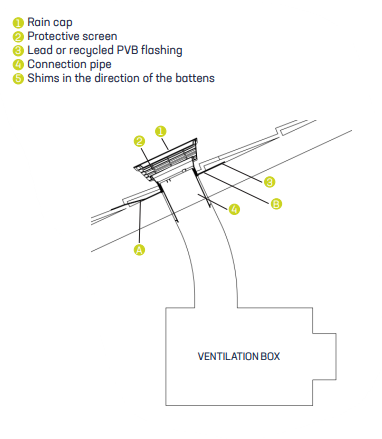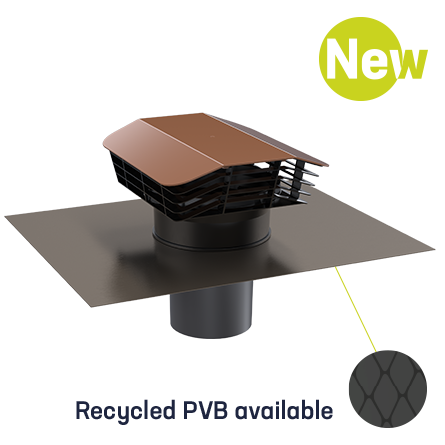Blog
Download our brochure

Stay informed
In response to evolving industry needs and environmental regulations, the new CTP2 plastic roof vent from Goveco has been introduced as the successor to the well-established CTP model. This transition marks a significant enhancement in roof ventilation technology, offering improved performance, compliance with modern building codes, and innovative eco-conscious design. This article explores the technical features, practical benefits, and the strategic considerations for HVAC professionals as the market phases out the CTP by January 2026.
Why the CTP2 roof vent replaces the previous generation
Over the past six months, the CTP2 roof vent has been gradually introduced as the new standard solution for roof terminal ventilation in both residential and commercial HVAC installations. This progressive change is part of Goveco's strategy to provide more efficient, durable, and sustainable products to its customers.
The current model, CTP, will officially cease production in January 2026. Professionals in the ventilation sector are encouraged to proactively begin transitioning to the new CTP2 product codes to avoid supply chain disruptions and ensure their product catalogs and projects are up to date.
CTP2 is not just a replacement; it represents a significant leap forward in design, performance, and sustainability, tailored for the modern construction landscape.
Key technical advantages of the CTP2
The CTP2 roof vent has been meticulously engineered to meet current construction standards, including energy efficiency and environmental performance under the French RE2020 regulation. Its features make it a reliable and forward-thinking solution for ventilation terminals.
- Optimized airflow performance: The CTP2 design significantly reduces pressure losses compared to the previous model, contributing to better system efficiency and reduced energy consumption.
- Modernized design: The external geometry has been reshaped to blend more naturally with modern roof styles. CTP2 is available in two diameters – Ø125 mm and Ø160 mm – and two color options: tile red and slate grey.
- Durability and weather resistance: The plastic material used in the CTP2 construction is formulated to withstand extreme outdoor conditions over time without degradation, ensuring long-term performance.
- Compliance with RE2020: Designed with the French environmental regulation RE2020 in mind, the CTP2 contributes to the energy and environmental objectives required in new construction.
- Innovative alternative to lead: CTP2 is the only roof vent currently on the market offering a lead-free option. Instead, it uses a recycled PVB sheet (polyvinyl butyral), which is lighter, safer, and environmentally responsible.
These features make the CTP2 not only more efficient in airflow management but also more aligned with the needs of contractors, builders, and designers working on sustainable projects.
The environmental impact of CTP2: sustainable ventilation in practice
Sustainability in building materials is no longer a trend but a requirement. The HVAC industry, in particular, is facing increasing pressure to provide environmentally responsible solutions. The CTP2 aligns with this demand by eliminating hazardous materials and incorporating recycled components.
One of the most groundbreaking features of the CTP2 is the substitution of traditional lead flashing with a recycled PVB sheet:
- Health and safety: By avoiding the use of lead, CTP2 eliminates a toxic substance from the roof system, reducing risks for installers and occupants alike.
- Recycled PVB material: Originally used in automotive windshields, PVB is a strong, flexible, and highly resistant material that is now being re-purposed into sustainable building components.
- Weight reduction: The lighter weight of the PVB alternative simplifies transportation, handling, and installation, especially on pitched or inaccessible roofs.
- Long-term resistance: PVB sheets exhibit excellent UV resistance, thermal stability, and durability over time, making them a viable alternative to traditional flashing materials.
This innovation not only makes the CTP2 unique in the market but also positions it as a future-proof solution in line with environmental certifications such as HQE, BREEAM, and LEED.

Installation and compatibility: practical considerations
From a practical standpoint, CTP2 is designed to ensure installation ease and compatibility with existing ventilation systems. It offers flexible use across a range of roof types and is compatible with both mechanical and passive ventilation systems.
- Diameter options: With Ø125 mm and Ø160 mm variants, the CTP2 covers the most common duct sizes used in residential and small commercial projects.
- Seamless integration: The vent can be connected to flexible or rigid ducts using standard accessories.
- Weather-tight installation: Thanks to its innovative sealing system and the PVB skirt, the vent maintains a watertight and airtight connection to the roof, reducing energy loss.
- Color integration: The two color choices (tile red and slate grey) allow the vent to visually blend into most roof coverings, preserving architectural aesthetics.
Contractors will appreciate the straightforward installation process, which reduces labor time and minimizes risk of error. Detailed installation guides are available on Goveco’s website and through its technical support team.
Looking ahead: how CTP2 supports future HVAC requirements
As building regulations continue to evolve towards more stringent performance and environmental goals, products like the CTP2 will play an essential role in ensuring compliance without compromising on efficiency or design.
In the coming years, we can expect increasing demand for:
- Low-carbon building materials
- Ventilation components compatible with heat recovery systems
- Long-life-cycle products with minimal maintenance requirements
- Smart product integration with digital building management systems (BMS)
CTP2 lays the groundwork for these developments by combining durability, aerodynamic efficiency, and environmental innovation. HVAC engineers, project designers, and specifiers should therefore see the CTP2 not only as a product replacement, but as a forward-thinking investment in sustainable infrastructure.
Conclusion: CTP2 as a new standard in roof ventilation
The CTP2 plastic roof vent from Anjos is more than an upgrade—it's a future-ready product that meets the modern demands of HVAC system design. With enhanced airflow characteristics, refined aesthetics, and a strong focus on environmental impact, CTP2 represents a new generation of roof terminals.
With the upcoming discontinuation of the CTP model in January 2026, professionals in the ventilation and construction industries are encouraged to begin the transition now. By integrating the CTP2 into ongoing and future projects, stakeholders will benefit from improved performance, reduced environmental impact, and compliance with evolving regulations.
To facilitate this process, Goveco provides full technical documentation, BIM support, and personalized assistance to partners around the world. Don't wait until the deadline—start incorporating CTP2 today and align your projects with the future of ventilation technology.

